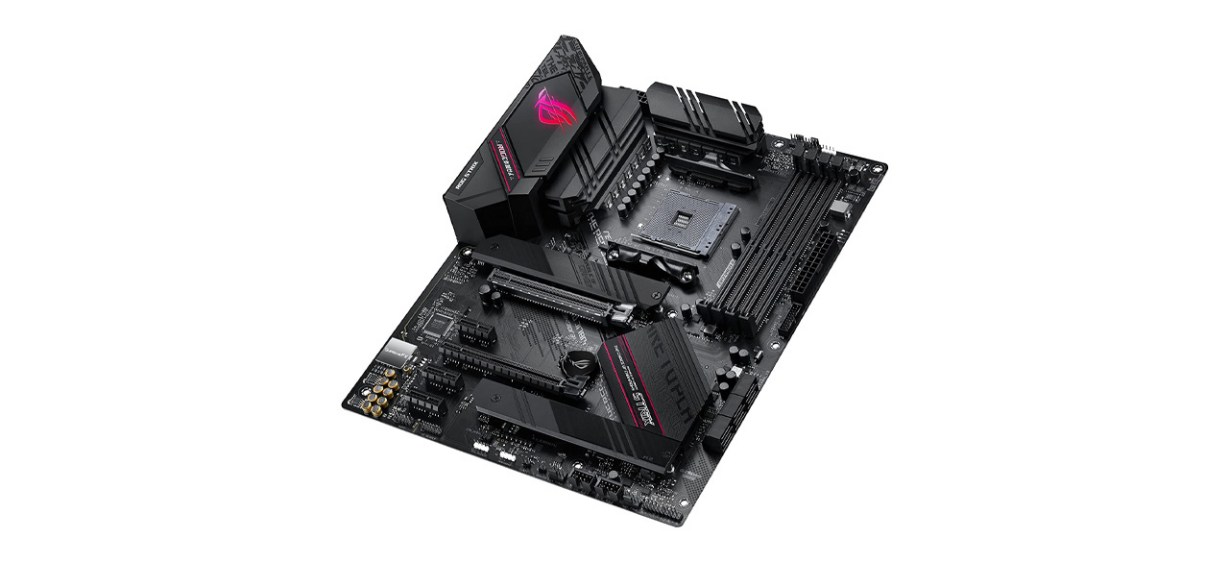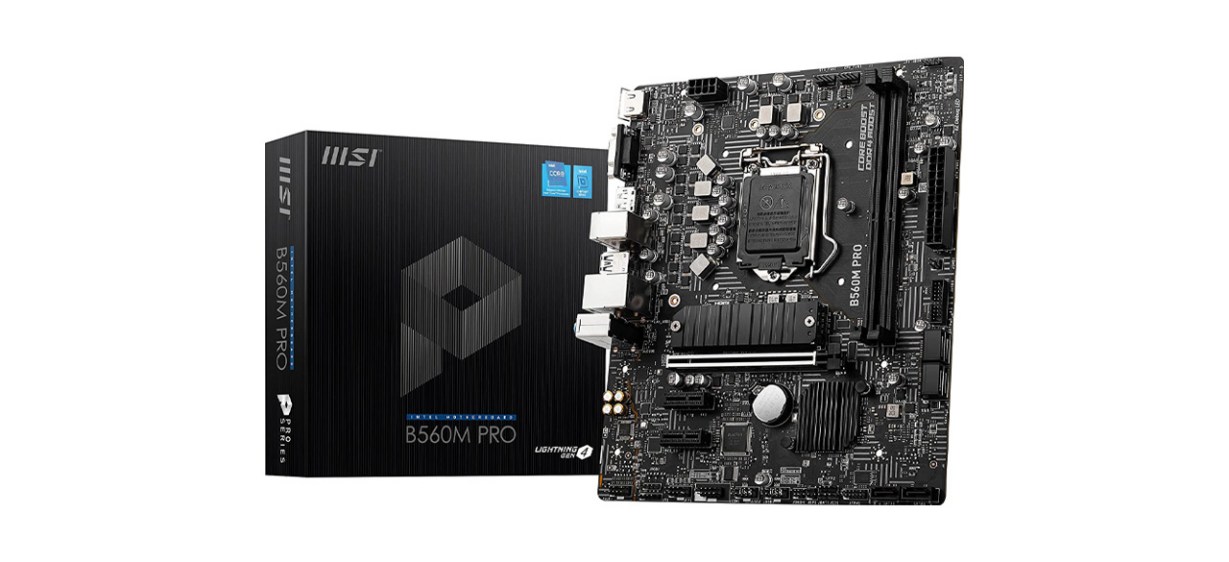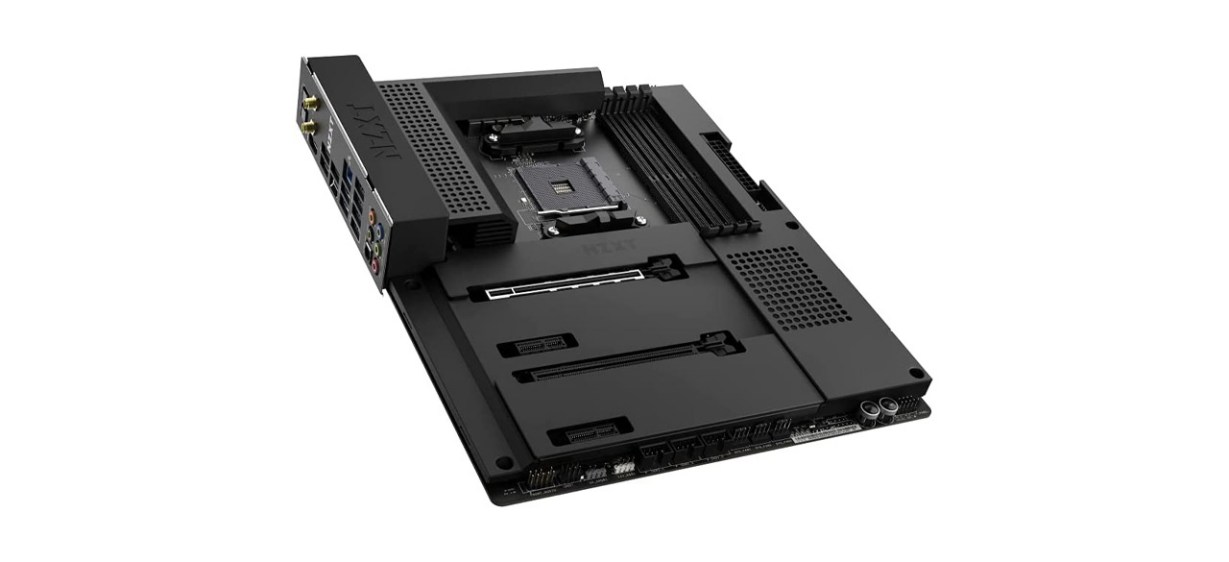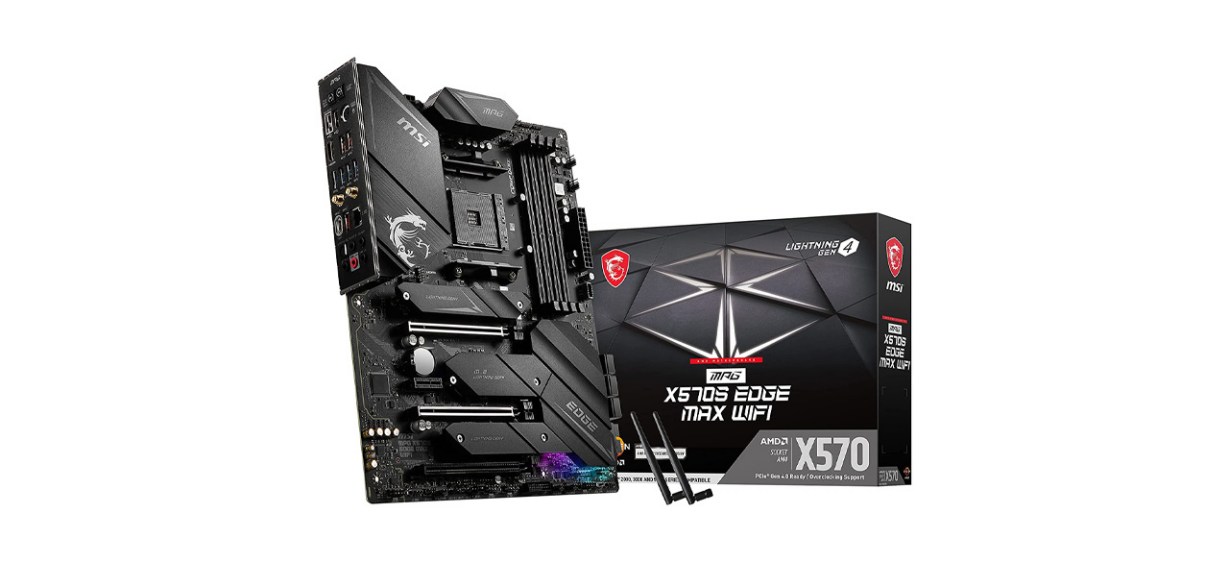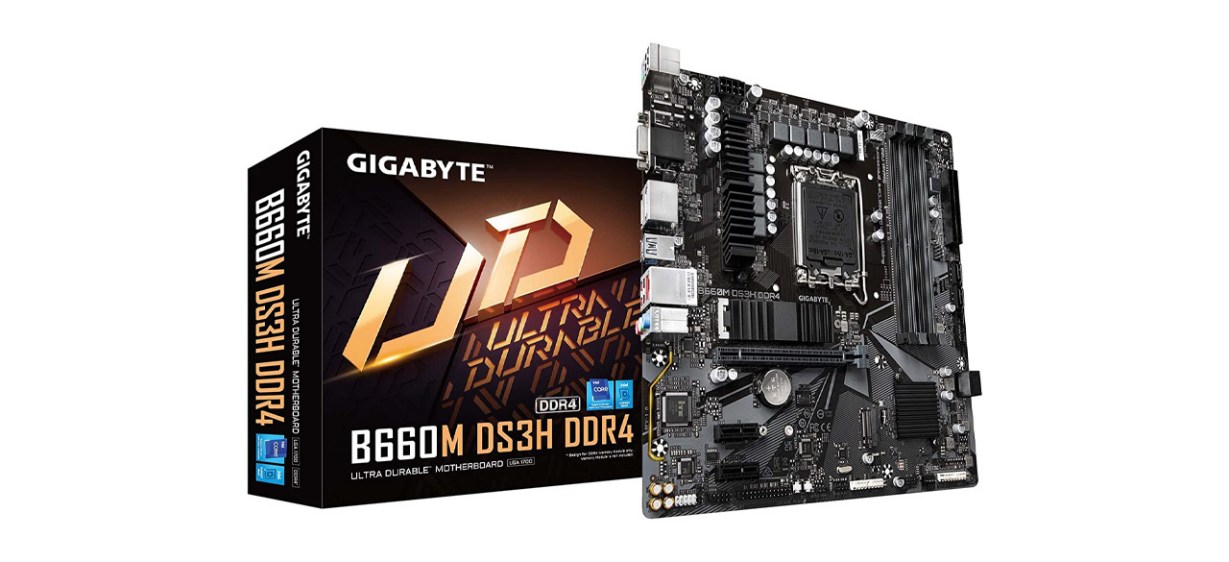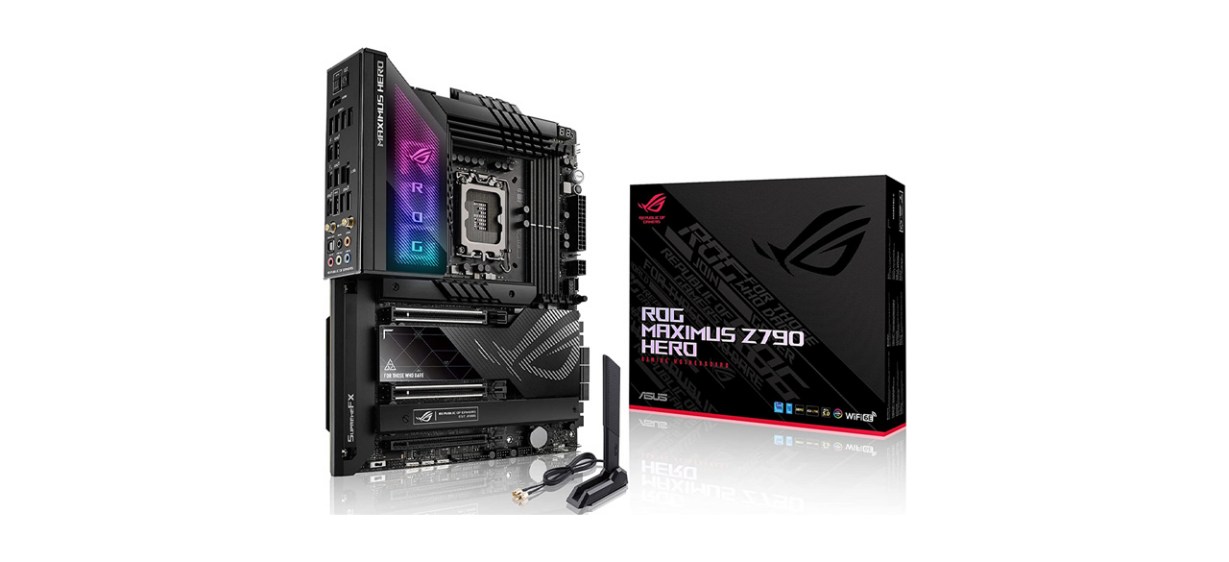BestReviews is reader-supported and may earn an affiliate commission. Details

Most find installation to be straightforward for this ASUS gaming motherboard.
Realtek 2.5GB Ethernet and TUF LANGuard are made for online gaming. AMD AM5 socket comes ready for AMD Ryzen 7000 Series desktop processors. Customers report excellent performance with a comprehensive cooling system.
Some reports of having to update the BIOS to most recent version.
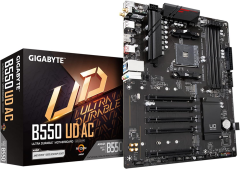
Solid option at an approachable price point.
Can't beat the price for this Gigabyte B550 motherboard that supports AMD Ryzen 5000 Series, 5000 G-Series, 4000 G-Series, 3000, and 3000 G-Series processors. Color-coded power switch pins help with installation. Includes onboard dual-band 802.11ac WiFi module from Intel.
Doesn't include a manual. You have to find it online.

The capable ASUS ROG Strix handles high-speed visuals and audio cues for immersive gaming.
Built-in M.2 slots, USB-C, and HDMI outputs offer plenty of connection opportunities. Supports a sizable 128 GB. Arrives with pre-mounted features that users can customize to their preferences, making it an excellent choice for DIY-ers. Straightforward to install, and indicator lights inform users if any errors occur.
Some reported issues with WiFi connectivity.

Offers studio-grade sound quality for immersive gaming and a simple installation that many users love.
This board is well-built and has a solid, hefty feel to it. Boasts a blazing-fast game experience with PCIe 4.0, Lightning Gen 4 M.2 with M.2 Shield Frozr, AMD Turbo USB 3.2 GEN 2. Easy installation makes this a solid choice according to purchasers.
Some customers are frustrated with the lack of expansion options.

Game-ready features and proven durability make this ASUS motherboard an excellent pick.
This motherboard is out-of-the-box Windows 11-ready with an Intel LGA 1700 socket. Customers find the Realtek S1200A codec provides high-quality audio and ASUS AI Noise Canceling Mic technology allows easy communication. Expect ultrafast wireless networking speeds with onboard WiFi 6E technology.
Some find the Windows 11 install to be a little tricky.

We recommend these products based on an intensive research process that's designed to cut through the noise and find the top products in this space. Guided by experts, we spend hours looking into the factors that matter, to bring you these selections.
Considered
Consulted
Researched



Buying guide for best motherboards
Have you ever wondered why anyone would want to build their own computer when you can buy one that’s pre-built and ready to go right out of the box? The answer is that many people prefer to customize their desktops to their particular needs. It’s often done by hardcore gamers or those who need a specific setup to operate their business more smoothly.
A motherboard connects every computer component, including the central processing unit, graphics cards and internal hard drives. There are many different kinds of motherboards, but your primary concern when buying one should be its size and what it can handle.
Our top pick, the Asus ROG Strix B550-F Gaming Motherboard, works with the latest AMD processors and is an excellent motherboard for avid gamers. It has onboard support for the latest wireless internet technology, Wi-Fi 6E, and has other neat features such as two-way AI noise-cancellation and customizable RGB LED lighting.
Best motherboards
Asus ROG Strix B550-F Gaming Motherboard
This motherboard is a favorite of those who want high-performance gaming. It’s suitable for desktops with an AMD Ryzen 3000, 5000 series, plus 5000 or 4000 G-series processors, and it has a user-friendly design for easy installation and setup. It has onboard Wi-Fi 6E and a built-in 2.5-gigabit ethernet port for a stable wired connection. It offers robust power with a high-end cooling system.
This ROG Strix gaming motherboard features customizable Asus-exclusive Aura Sync RGB lighting, with Aura RGB and addressable Gen 2 RGB headers, and superb gaming audio with two-way AI noise-cancelation, SupremeFX S1220A codec, DTS Sound Unbound and Sonic Studio III.
MSI B560M ProSeries Motherboard
You don’t need a gaming desktop with an AMD processor for this motherboard, as it’s compatible with 11th and 10th Gen Intel Core/Pentium/Celeron processors. It’s an excellent business-optimized motherboard, and the premium Intel B560 chipset supports RGB LED devices and includes EZ debug LEDs.
It supports DDR4 Memory, up to 5200 megahertz, and the layout is designed to support more cores for increased power and improved performance. The integrated cooling features protect the circuits from overheating, and MSI PCI Express Steel Armor slots are secured to the motherboard to support heavy graphics cards. The M.2 Shield Frozr also ensures fast solid-state drive transfer, even at low or high temperatures.
NZXT N7 B550 Gaming Motherboard
At the substantial price of $450, we only recommend this motherboard for avid PC gamers. It’s compatible with 3rd Gen AMD Socket AM4 Ryzen Processors and offers several high-end features, including Wi-Fi 6E, digital RGB and fan controls, and two M.2 connectors for storage devices.
The sound quality is excellent as it boasts Realtek ALC1220 Codec, eight-channel HD audio and Nichicon Fine Gold Series Audio Capacitors. The streamlined layout makes installation easy since it has an integrated rear I/O shield and strategically-positioned headers. It supports additional lighting accessories from all manufacturers and has multiple ports and slots for PC expansion.
MSI MPG X570S Edge Max Wi-Fi Gaming Motherboard
This motherboard is one of the more affordable gaming motherboards on the market, but we love it for many other reasons. It’s compatible with most of the latest AMD Ryzen processors, and the power system is optimized to enhance gaming as it boasts a Duet Rail Power System, an eight-pin plus four-pin CPU power connectors, core boost and DDR4 Boost.
One other nice feature of this motherboard is that you can set four specific temperature targets to adjust fan speeds to prevent overheating and facilitate optimal performance. Also, this motherboard has ports for all peripherals, including optical and USB cables.
Gigabyte B660M DS3H Motherboard
If you want a solid motherboard but don’t want to spend too much, this is an excellent value pick. It’s optimized for business use as it supports all 12th Gen Intel Core Series processors and incorporates DualBIOS technology for elite performance.
The Windforce Stack 3x Cooling System keeps your equipment running optimally and helps prevent circuits from overheating. It offers several fine-tuning features such as RGB Fusion 2.0, customizable RGB LED Strips and Smart Fan 6 for reduced boot-up times. You’ll also get dynamic sound thanks to high-end audio capacitors.
Asus ROG Maximus Z790 Hero Gaming Motherboard
Although you’ll spend a pretty penny on this motherboard, you won’t be disappointed, especially if you’re a hardcore gamer. It costs $600 but offers several high-end features and elite performance to deliver an enhanced gaming experience that makes it worth it for the most avid gamers.
It has onboard Intel Wi-Fi 6E and a 2.5-gigabit ethernet port, and it works with all 13th and 12th Gen Intel Core processors and features several Asus-exclusive tools for optimizing your PC. They include AI overclocking and AI Cooling II for automatically predicting optimal frequency and voltage for high-end performance and two-way AI noise-cancelation for enhanced sound quality.
Gigabyte Z690 Aorus Ultra Motherboard
Offering top-tier power and support for 12th Gen Intel processors, this motherboard is excellent for any user looking for quick and easy PC expansion options. It has an advanced-engineered thermal design for regulating temperatures and adjusting performance. It also offers fast Wi-Fi 6 support as well as a 2.5-gigabit ethernet port for reliable and stable wired connections.
LC4080 and WIMA audio capacitors mean you’ll get excellent sound quality for an immersive listening experience. Gigabyte offers several customization features where you can fine-tune RGB lights and Q-Flash for updating BIOS without installing a CPU, GPU or memory. Plus, it has several connectivity ports for all necessary peripherals and accessories.
What to know before buying a motherboard
Desktop vs. laptop
Both desktop and laptop computers make use of a motherboard. However, if you’re building your own computer, you’ll probably have to stick to a desktop format. Because laptops are so thin, it can be challenging to fit all the components into the case with a DIY computer. Most laptop motherboards incorporate customized designs rather than being mass-produced. Most motherboards for sale, such as the ones in our product list, are aimed at desktop computer builders.
Processor socket
The processor socket determines the size and type of computer processing unit you can use. If you’re purchasing a newer CPU, such as an Intel or AMD processor, it should fit in various motherboard form factors.
Some motherboards, such as the Raspberry Pi 3 Model B, use ARM-brand CPUs. But ARM processors, in general, are designed for environments where conserving electrical power is essential. CPUs from Intel and AMD tend to offer more features and tend to have more processing power.
Gaming
If you want to create a powerful gaming computer, you must ensure it supports multiple graphics expansion cards. The correct number of PCI-e x16 expansion slots is required to support AMD or Nvidia’s protocols for using various graphics cards. Along those same lines, if you want high-end audio capabilities in your gaming computer, ensure that the expansion slots can handle the audio card you wish to use.
Form factor
The form factor you want to use with your computer will determine the motherboard size. If you already have a case in mind, you’ll need to buy a motherboard that fits it. The motherboard size also determines how many expansion slots fit on it. The most common form factor options are as follows, listed from largest to smallest:
- EATX: Short for Extended ATX, the EATX form factor is aimed more at the server market. It has seven expansion slots and measures about 12 by 13 inches.
- ATX: The ATX form factor is the most common, offering seven expansion slots. It’s also large, measuring about 12 x 9 5/8 inches.
- Micro-ATX: This has four expansion slots and is square, measuring 9 5/8 inches on all four sides.
- DTX: The DTX is a form factor that’s wider than it is long. It has two expansion slots and measures 8 x 9 ⅝ inches.
- Flex-ATX: This board is narrower than most options. The Flex-ATX form factor has three expansion slots and measures 9 x 7 1/2 inches.
- Mini-ITX: You’ll only get one expansion slot with this square form factor Mini-ITX motherboard. It measures 6 3/4 inches on all four sides.
Chipset
The chipset fits on the motherboard and works with a particular CPU. So you’ll want to select a processor and compatible motherboard first and then pick a chipset that goes along with them. A chipset determines the number of memory channels you can use. It offers support for a certain number of PCI-e lanes, SATA ports for connecting hard drives and USB ports. It also provides support for any overclocking options. In addition, the chipset determines the type of memory you can use.
Memory
Different motherboards offer a variety of slots to accommodate memory chips, also called random-access memory (RAM) chips. It’s best to select a motherboard that can use four memory slots versus the two slots smaller boards use. Expanding the amount of RAM the computer has is an excellent way to improve the performance of the computer after a couple of years. However, if you need a smaller form factor motherboard, you can upgrade the RAM chips in the two memory slots down the road.
Cooling
Plan for a proper cooling system if you’re building a powerful PC. Excessive heat is dangerous to computer components and the motherboard itself, so any motherboard layout you pick must accommodate the proper placement of cooling fans and sufficient airflow.
Comparing performance levels
Once you’ve settled on the options you want in a motherboard purchase, it’s time to compare performance levels. Do some internet research to find the motherboard models with the best benchmarking results. Reviewers commonly measure the speed and performance levels of motherboards in the following areas:
- Boot times: The amount of time required to boot a computer depends, in part, on the motherboard’s components and firmware, including the BIOS.
- Memory bandwidth: This measures the amount of data that can be moved to and from the memory chips. Loading more data in memory faster is better, and the motherboard design plays a role in the available speed.
- Power usage: Look for measurements of the motherboard’s power consumption during regular working and idle times. Motherboards that use more power consume more energy, but they will also generate more heat, which can damage computer components over time.
FAQ
Q. How much does a motherboard cost?
A. A motherboard that costs $100-$300 typically offers multiple options for integrated components, including WiFi. If you want to use multiple graphics cards, you should be able to do so with these boards, and you can find quite a few expansion slots on these motherboards as well. Motherboards that cost $250-$600 will let you overclock your processors, and you’ll receive the most RAM and expansion card slots with these boards. Hardcore gamers and video editors will need these types of motherboards.
Q. When upgrading a motherboard, what do I need to know?
A. Start by selecting the type of processor you want to use, and make sure the CPU socket on the motherboard is compatible. If you need more flexibility in terms of RAM slots and expansion card slots, look for a large form factor. All of the other choices for computing components you need to make can fill out from there.
Q. How do I set a budget for my DIY motherboard project?
A. You’ll need to purchase a processor, a chipset, memory chips and expansion cards. So before selecting the type of motherboard you want, make sure that all of the components you need will fit inside your total budget. There’s no point in buying an expensive motherboard if you can’t afford enough components to take advantage of it.
Q. How do I know if I can replace a broken motherboard in my current computer?
A. You can replace the same motherboard form factor and CPU socket to match the broken one as long as you can still buy it. However, it’s crucial to note that it can be challenging to reseat the old components in the new motherboard, and it’s often easier to start from scratch with new parts. However, this process can be completed successfully with some patience and know-how.
- Best iPads
- Best E-readers
- Best Computer Monitors
- Best Smart Keyboards
- Best Monitor Stands
- Best RAM
- Best Ethernet Cables
- Best Tablet Cases
- Best TaxSlayer Tax Preparation Software
- Best TaxAct Tax Preparation Software
- Dell just dropped prices on laptops, desktops, monitors and headphones
- Microsoft debuts the Surface Thunderbolt 4 Dock
- Microsoft unveils plans to use AI feature in Outlook, Excel and more
- Acer Chromebook vs. HP Chromebook
- Best computer deals for Prime Day 2022
- Best Corsair gaming keyboard
- Nvidia 3000-series graphics cards now cheaper on Amazon: Which one’s right for you?
- Best Dell Inspiron laptop
- Best Samsung curved monitor
- Best Amazon Fire tablet
- Best ultrawide monitor
- Best Chromebook accessories
- Best microSD card
- Best wireless mechanical keyboard
- Best budget gaming keyboard
- AOC portable monitor vs. Asus portable monitor
- Lepow portable monitor vs. Asus portable monitor
- Lepow portable monitor vs. AOC portable monitor
- Best Antivirus Software
- Best TurboTax Software

